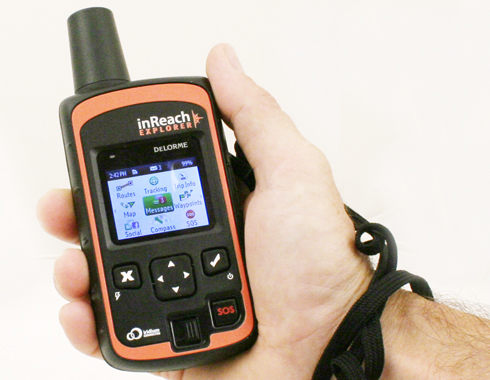
New portable satcom devices are popping up every spring and fall, and were trying to test them as quickly as they come in.
Last month, I had the chance to do some preliminary testing of Delormes InReach Explorer. The inReach Explorer is the third generation of the original inReach that we tested in March 2013. Later that year, Delorme added a display screen to the device and additional functions, calling it the inReach SE. We have not tested the inReach SE, but it is very similar to the Explorer.
The Explorer adds several more functions to the SE frame, including an internal digital magnetic compass, altimeter, and accelerometer that allows for rudimentary route planning. The device is not intended to be a full-fledged handheld GPS navigator; its a communication device with some navigation features.
Like the original inReach, the GPS-enabled Explorer synchs via Bluetooth with Android (including the Kindle Fire) or iOS devices, allowing you to send and receive texts with multiple people. It also allows them to follow your progress on the Internet. The small display screen is the key feature, enabling you to send and receive texts without synching to another device. (Used alone, the original inReach allowed you to send only one of three texts pre-composed by the user-Im OK, Delayed, etc.)
In an effort to keep pricing down, ensure ruggedness, and simplify use, the Explorer has just three control buttons (an additional button and switch are dedicated for SOS), which means that using the inReach Explorer alone to send texts requires selecting each letter one at a time from an alpha-numeric display. Even with the aid of the Explorer’s smart auto-fill software, this is a tedious process. If you are sending more than a few words, synching the device to another device makes sense. It is also smart to have several useful pre-canned messages that can be sent with few button-pushes.
Im amazed by the rate at which the world of handheld sat-com devices is changing. Previously, in January 2013 we compared two send-only devices, the Cerberus Ceberlink and the Spot Connect. A year later, we looked at the Spot Sat Phone. All of these devices work via a satellite provider (Iridium or Globalstar) and require a monthly or annual service plan. As with cell phones, it can be difficult to decide which plan best suits the way you use your device. We compared pricing in the March 2013 article comparing the inReach to the Iridium Extreme satphone.
The service plans for the Explorer-with Delormes no-contract Freedom plan-appear competetive, even if you figure in the cost of the device. Suggested retail price for the unit is $379. Service plans start at $15 (no contract) for basic safety service and go up to $100 a month for more comprehensive unlimited plans.
I havent yet spent enough time evaluating the the Explorers newest features to see if these make it so more desirable than the inReach SE. Priced at just under $300, the inReach SE offers the same messaging features that sailors seem most interested in.
So far, Im most impressed with the Explorers simplicity. Setting it up to send and receive texts, even share tracking, was dead simple, and even the least tech-savvy on my mailing list were able to follow our progress at sea.
While these new satellite communicators are extremely useful for a number of tasks, including sending out calls for help, we still do not recommend them as a primary means of distress calling. Depending on where you are sailing, you should first invest in a VHF radio, Personal Locator Beacon, or GPIRB to be used for distress calls. Portable satellite communicators are excellent supplements to these traditional forms of distress calling. Their ability to provide two-way communication is especially valuable when you need some form of assistance, but the situation is not an emergency.
A more detailed report on the inReach Explorer will appear in an upcoming issue of Practical Sailor.








































